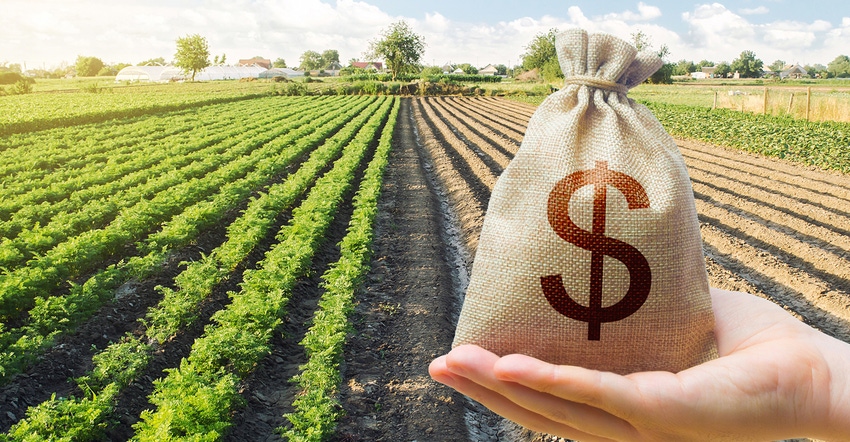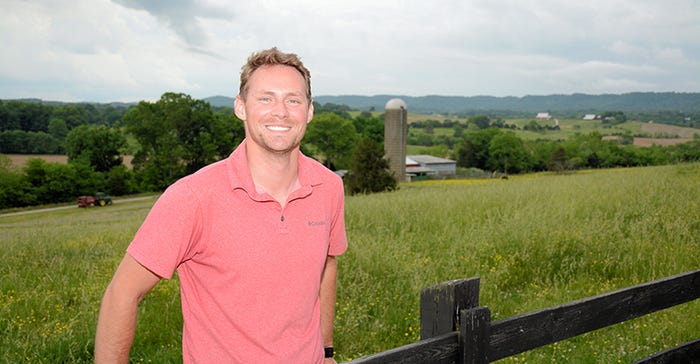
Like most young farmers, Quint Pottinger has had his share of frustrations with lenders as he worked to expand his farm operation.
Pottinger, who grows corn, soybeans and wheat at Affinity Farms near New Haven, Ky., tried establishing relationships with local lenders, only to see them jump ship to new jobs at different banks.
“Young farmers always get that advice -- get a good relationship with a lender, something that lets you grow,” he says. “From my experience a lot of ag lenders change companies frequently so you could never develop trust. We were never able to build a relationship because of that.”
That’s why four years ago Pottinger turned to a relatively new lending option – FarmOp Capital, founded in 2017 and headquartered in St. Paul, Minn. Instead of lending based on collateral assets like land and equipment, the company provides operating loans based on the value of your future crop, your marketing strategies, and your use of crop insurance. Any crop that can be insured and hedged is eligible.
FarmOp claims to fill a void that traditional lenders have difficulty underwriting, explains Bill York, an ag lender with Farm Credit and CNH Capital before becoming FarmOp Capital CEO.
“We’re seeing more and more growers renting acres to expand their land base, and that doesn’t fit well in the traditional box for many lenders,” says York.
Pottinger says FarmOp offered a better interest rate. But the main draw was flexibility.
“The way they structure the note allows us to grow,” he says.
And grow they have. Affinity Farms expanded from 1,200 acres in 2018 to 2,200 acres today, and used FarmOp each year for operating loans. To Pottinger, the crop insurance commitment was a no brainer since it’s the “best subsidy in ag and greatly reduces risk,” he says. The increased commitment to hedging crops was more daunting, but has so far proven successful.
“A portion of your loan has to go to hedging and I’ve never been able to get a bank to work with me that way,” says Pottinger. “This is nice because it’s money dedicated to reducing my exposure to the market. I’ve always done some hedging but never to the scale I’m doing now.”

No ordinary lender
According to York, the segment of operators who rent more than own land is growing rapidly. For farmers who own some land but see rented acres as a way to expand or transition to the next generation, traditional lending metrics don’t always result in obtaining the money they need in a timely fashion.
“With the rising value of farmland, those top 8% of farmers who grow 65% of the crops are more likely to rent future acreage rather than buy future acreage,” he says. “This loan fits those farmers. We’re different because we’re going to be very intimate with the farmer’s marketing plan and structure the loan specifically around the value of the crop.”
FarmOp lenders examine your balance sheet to gauge working capital. They look at production history to gauge risk. But they mainly look at your willingness to invest in crop insurance and marketing tools to protect the future value of what you grow.
“We believe the money you spend to buy calls or puts, for example, is well spent, so we will finance the cost of those risk mitigants,” says York. “We will finance any options they purchase, any crop insurance they purchase, or incremental pesticides -- whatever they need to protect their crop.”
The farmer’s experience
Pottinger talks with FarmOp staff at least twice a week. “You have to lean into that – contact them and communicate the financial side of the farm,” he says. “They remind me when things come due. It’s created a level of organization we didn’t have before, like having an accounting team for your farm. It relieves some head space to focus on other things.”
FarmOp customers work with a variety of approved Commodity Trading Advisors who support the marketing component of the loan. One of those CTAs is AgYield, a company dedicated to helping farmers better manage revenue. Throughout the year, FarmOp borrowers get calls from their CTAs to get updates on sales, make decisions on hedging, or to lock in cash bids, for example.
“They trade and watch the market every day,” says Pottinger. “They’re available to provide advice based on whatever level the farmer is comfortable with. You can still work with your preferred market adviser, but if you have a loan with FarmOp you’d still get a call from an AgYield expert.”
Not for everyone
The FarmOp loan won’t work for everyone, especially if you don’t want to hedge commodities. And FarmOp is not a revolving line of credit. Loans are based on an 18-month window starting the summer before the next growing season so you can get cash to buy inputs for the following year.
“That flexibility is important for a farmer to grow and take advantage of market movement,” says Pottinger.
FarmOp’ s loan has two buckets of expenses to draw from. Invoiced and un-invoiced expenses are handled differently. For ‘un-invoiced,’ costs, borrowers need to have some flexible funds to pay various venders who might, say, need immediate cash or a check.
“It’s a little difficult,” notes Pottinger. “You do have to plan more. What I’m learning is, there are invoices I can take pictures of and use so I’m not burning through that ‘un-invoiced’ expenses account. You have to be forward thinking about how all your expenses get paid. I’ve been trying to use the ‘un-invoiced’ expenses account more like an emergency account -- use as needed.
“This is based on an 18-month inventory. Farmers are good at 12 month planning and looking ahead in that window but this makes you expand that window, solve things, put pen to paper, with other business partners involved.”
Timing can be tricky.
“The most interesting part of working with this group when it comes to getting things finalized is in crop insurance,” says Pottinger. “Crop insurance agents will work with the FarmOp people but they may not be ready when FarmOp wants information. Last year my loan was wrapped up in December, but we typically don’t get insurance lined out until March, which was a new issue we had to work through to get our operating loan finished.”
All loans are different, but in Pottinger’s case, once crop insurance was finalized and the old loan paid off, FarmOp set up the most recent loan with five draw amounts starting late last summer and running throughout next year’s crop season.
“We set those up based on when you need capital --for example, to pay off rents,” says Pottinger. “So the first 40% of funding will be to buy inputs in fall, another 20% might be available in January for rents, and other draws are set up in April, August and October.”
Getting that loan locked in early is helpful to operators looking to add more rented acres before a new growing season begins; they need to know they can get operational funding for those acres. The FarmOp loan includes an early spring ‘accordion feature,’ which makes the loan expandable, York explains. “If prices go up or the operator has expanded their land base, we can expand the loan.”
Pottinger’s operation got 100% of the funding he wanted, mainly thanks to the hedging aspect of the loan.
“Lenders using just crop insurance as collateral can only lend up to what the crop insurance pays back, but lenders who use hedging as a risk tool will be able to provide 100%,” says Pottinger. “They want us to be able to secure seed, fertilizer and chemicals in the fall for potential discounts before year end. This is the first time we’ve been able to do this.”
The value proposition
To some degree the borrower controls how much he or she gets in the FarmOp operating loan. If they decide to go with an aggressive marketing strategy with forward pricing, put options, or other tactics that place a price floor under the crop and a high level of crop insurance, FarmOp will likely lend 100% of the money needed for that crop. If you prefer to leave some crop unprotected, FarmOp will likely lend less.
“We don’t make the decisions for the farmer, but the decisions they make will drive how much we can lend them,” says York. “He or she control that decision.”
In 2021 FarmOp had 100 customers with average loans of $3.5 million.
About the Author(s)
You May Also Like






